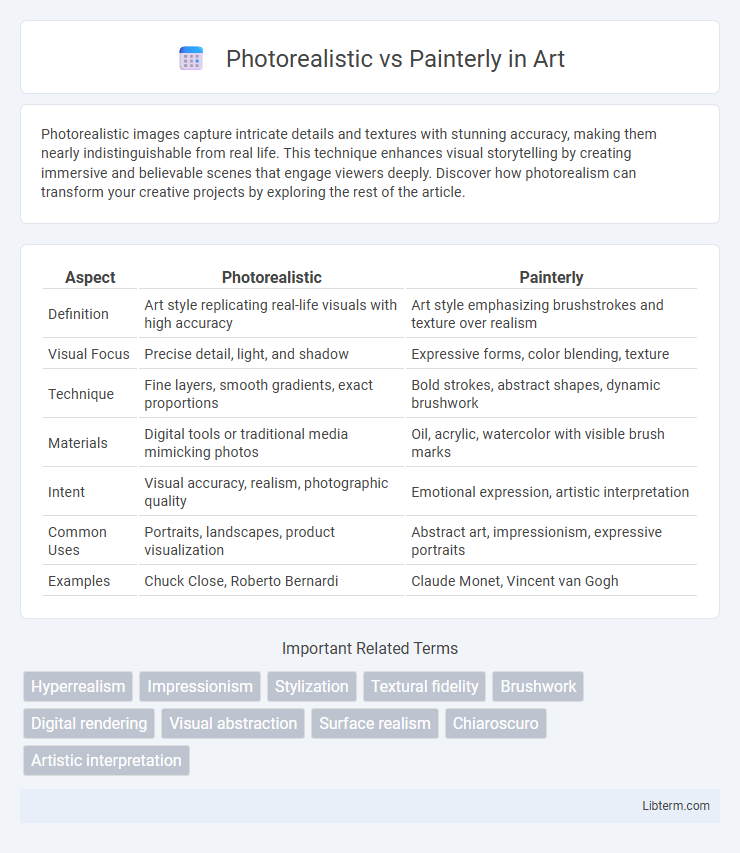Photorealistic images capture intricate details and textures with stunning accuracy, making them nearly indistinguishable from real life. This technique enhances visual storytelling by creating immersive and believable scenes that engage viewers deeply. Discover how photorealism can transform your creative projects by exploring the rest of the article.
Table of Comparison
| Aspect | Photorealistic | Painterly |
|---|---|---|
| Definition | Art style replicating real-life visuals with high accuracy | Art style emphasizing brushstrokes and texture over realism |
| Visual Focus | Precise detail, light, and shadow | Expressive forms, color blending, texture |
| Technique | Fine layers, smooth gradients, exact proportions | Bold strokes, abstract shapes, dynamic brushwork |
| Materials | Digital tools or traditional media mimicking photos | Oil, acrylic, watercolor with visible brush marks |
| Intent | Visual accuracy, realism, photographic quality | Emotional expression, artistic interpretation |
| Common Uses | Portraits, landscapes, product visualization | Abstract art, impressionism, expressive portraits |
| Examples | Chuck Close, Roberto Bernardi | Claude Monet, Vincent van Gogh |
Understanding Photorealistic and Painterly Styles
Photorealistic art emphasizes meticulous attention to detail, aiming to replicate real-life visuals with high precision and clarity, often using techniques such as light reflections and textures to enhance realism. Painterly style prioritizes expressive brushwork, vibrant colors, and visible textures, focusing on conveying emotion and atmosphere rather than exact replication of reality. Understanding these styles involves recognizing photorealism's reliance on technical accuracy versus the painterly approach's celebration of artistic interpretation and spontaneity.
Key Characteristics of Photorealistic Art
Photorealistic art is defined by meticulous attention to detail, aiming to replicate photographs with high precision and clarity. This style emphasizes accurate lighting, texture, and color gradients to create a lifelike representation of subjects. The use of fine brushwork or airbrushing techniques enhances the illusion of reality, setting photorealism apart from more abstract or painterly styles.
Defining Features of Painterly Techniques
Painterly techniques emphasize visible brushstrokes, textured surfaces, and dynamic color blending that convey emotion and movement. Unlike photorealistic art, which strives for precise detail and smooth gradients, painterly works often showcase spontaneous, expressive marks that reveal the artist's hand. This approach prioritizes atmosphere and interpretation over exact replication of reality.
Historical Evolution of Artistic Styles
Photorealistic art emerged in the late 1960s as a reaction against abstract expressionism, emphasizing meticulous detail and lifelike representation to mirror photographic precision. In contrast, painterly styles trace back to Renaissance masters who valued expressive brushwork and emotional depth, evolving through Impressionism and Post-Impressionism to highlight texture and subjective interpretation. The historical evolution reveals a dynamic tension between accurate depiction and artistic expression, reflecting changing cultural values and advances in artistic techniques.
Tools and Mediums: Digital vs Traditional Approaches
Photorealistic art relies heavily on digital tools like Photoshop, advanced rendering software, and 3D modeling programs to achieve precise details and realistic textures, whereas painterly styles favor traditional mediums such as oil paints, watercolors, and acrylics that emphasize brushstroke texture and color blending. Digital approaches offer layered editing, undo capabilities, and high-resolution zoom for meticulous adjustments, contrasting with the tactile, hands-on process and unpredictable effects inherent in traditional painting. Both methods exploit their tools' unique qualities to define the visual outcome, with photorealism prioritizing exact replication and painterly techniques embracing expressive, interpretive marks.
Comparing Techniques: Brushwork and Detailing
Photorealistic art emphasizes precise brushwork and meticulous detailing to replicate reality with high fidelity, capturing textures, light, and shadows exactly as they appear. Painterly techniques prioritize expressive, visible brushstrokes and dynamic forms over exact replication, using detail selectively to evoke emotion and atmosphere. Comparing these approaches highlights photorealism's commitment to clarity and precision versus painterly art's focus on movement and interpretive representation.
Emotional Impact: Realism versus Expression
Photorealistic art emphasizes meticulous detail and lifelike representation, evoking emotional impact through familiarity and precision that anchors viewers in reality. Painterly art prioritizes expressive brushstrokes and abstract forms, generating emotional resonance by conveying mood, movement, and subjective experience rather than exact likeness. The contrast between photorealism and painterly styles highlights the tension between emotional responses driven by accurate depiction versus those inspired by artistic interpretation and personal expression.
Applications in Contemporary Art and Media
Photorealistic art emphasizes high-resolution, lifelike imagery that closely mimics real-world visuals, frequently applied in advertising, digital media, and virtual reality to enhance viewer immersion. Painterly techniques prioritize expressive brushstrokes, texture, and abstraction, making them prevalent in contemporary galleries, mixed media installations, and concept art for engaging emotional and interpretive responses. Both styles intersect in augmented reality and video game design, where photorealism attracts precision realism while painterly aesthetics contribute to artistic innovation and narrative depth.
Choosing the Right Style for Your Project
Photorealistic style excels in projects requiring lifelike detail and accurate representation, making it ideal for architectural visualizations, product designs, and realistic game environments. Painterly style offers expressive brushstrokes and artistic interpretation, perfect for conveying mood, emotion, and creativity in illustrations, concept art, and storytelling. Selecting the right style depends on project goals, audience expectations, and the desired emotional impact, balancing technical precision with artistic freedom.
Future Trends in Artistic Representation
Photorealistic art continues to evolve with advancements in AI-driven rendering and 3D modeling, enabling hyper-realistic textures and lighting that blur the line between photography and digital art. Painterly styles are gaining renewed interest through augmented reality and VR platforms, which offer immersive experiences that emphasize brushstroke textures and dynamic color modulation. Future artistic representation will likely merge photorealistic precision with painterly expressiveness, leveraging machine learning to create hybrid forms that redefine visual storytelling.
Photorealistic Infographic

 libterm.com
libterm.com